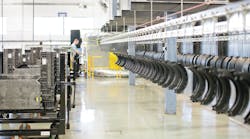Bendix’s Richard Nagel discusses how remanufactured parts can benefit fleets, addresses some of the misconceptions about this product category and talks about remanufactured component trends we can expect to see in the future.
Transcription of interview:Erica Schueller, Fleet Maintenance: Welcome to VSP News: Uptime Update. I am your host Erica Schueller, Editor-in-Chief of Fleet Maintenance magazine, covering all maintenance, all management, all vehicle classes, all the time.Using quality remanufactured parts can provide a number of benefits to a fleet, including cost savings, better performance and a reduced impact on the environment.
But, many companies that remanufacture parts are still working to educate the industry on the benefits and value of these products.
We talked with Richard Nagel, Director, Marketing and Customer Solutions at Bendix Commercial Vehicle Systems about remanufactured parts, and the misconceptions about this product category.
Richard Nagel, Bendix: Remanufacturing is quite simply, when we take a component that’s already been in service a couple of years – we typically buy that core on the market, take it back to our facility and recondition all the parts that we can recycle from that, and then replace with new components. Especially the wear parts, things that are meant to wear out over time.
For remanufacturing, it’s essentially like a brand new component after we’re done with it.
One of the misconceptions about remanufacturing is it’s old and used, and that’s really not the case because most of the parts that we remanufacture are non-critical wear type items. Of course, anything that needs to be replaced is replaced with factory new. Sometimes a remanufactured part can be 50-percent brand new. It is like a brand new product when it comes out of the factory.
Schueller, Fleet Maintenance: After getting past the misconceptions of remanufactured parts, it’s still important to ensure you’re purchasing a quality component.
There are criteria fleets can keep in mind when reviewing the integrity of remanufactured parts.
Nagel, Bendix: One of the key things to know about remanufacturing is that at the highest level is, what Bendix calls, a genuine remanufacturing, where typically the original manufacturer also remanufactures the product.
Some of the attributes you need to look for in a remanufacturer are:
- Good engineering knowledge – how it works, how it’s used.
- A good supply chain, to make sure that the components going into the remanufactured product are up to new quality.
- Process is very important. Bendix tends to use the same OE-type manufacturing process.
- Be aware of the brand. Look for things like trade dress to make sure the components being substituted are factory original.
- Know your source, and look at the past history.
Schueller, Fleet Maintenance: While this information is useful for vetting a quality remanufacturer, there are some other types of parts – such as the process for making rebuilt components or cloned components – that are sometimes mistakenly placed in the same category as remanufacturing.
Nagel talks about the key differences in these types of components.
Nagel, Bendix: The difference between remanufactured, rebuilt and clones is a pretty wide range of differences.
For remanufacturing, it’s being brought up to factory, like-new.
Rebuilt is typically what we think of as “triage” – the component gets back in, the rebuilder uses whatever components are available, usually the product is bench tested, it works okay and is usually to get the customer out of a bind. We don’t think of it as a long-term, high-reliability solution.
Clones are a whole other world. It’s typically a reverse-engineered product that’s sourced from a low-cost country. It looks like the original manufacturer, but it’s hit or miss sometimes. Those products aren’t typically remanufactured, they very often go to landfills. Or if they do get remanufactured they go into a wide category of all-makes rebuild.
Schueller, Fleet Maintenance: Looking to the future, what continuing trends can we anticipate with regards to remanufactured components? Nagel shares his insights.
Nagel, Bendix: I see three major trends. One is certification for remanufacturers – organizations like MERA that let customers know exactly what type of facility the remanufacturing takes place on.
Secondly, there is a new generation of components – things like air disc brakes, for example, that have been growing in popularity; safety systems; radar; electronics – that are becoming part of the remanufacturing portfolio.
Lastly, we are seeing more and more house-type brands that compete with remanufacturing.
So it’s really up to the industry to differentiate the benefits of remanufacturing versus all of these like-new type products you’re seeing on the market today.
Find out more information about how Bendix and other remanufacturers are working to create transparency with the reman process.


